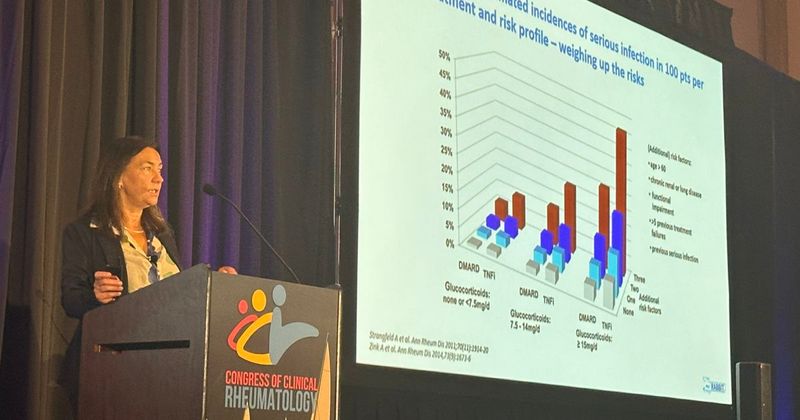Systemic inflammation an ‘important risk factor’ for stroke, ILD in rheumatoid arthritis
SAN DIEGO — Managing systemic inflammation is critical to reducing cardiovascular and pulmonary outcomes in patients with rheumatoid arthritis, according to a presenter at the 2024 Congress of Clinical Rheumatology West.
“Systemic inflammation is really an important risk factor for all kinds of comorbidities that we see,” Anja Strangfeld, MD, professor of epidemiology and health services research at the Charité – University Medicine Berlin and the German Rheumatism Research Center Berlin, told attendees.

Strangfeld presented findings on comorbidities and outcomes in RA from the RABBIT registry, which includes data for more 17,000 patients with the disease treated by approximately 400 rheumatologists across Germany.
One question the group asked pertained to patients with RA who experience myocardial infarction. They paired patients from the registry who had an MI with controls of the same age, gender, comorbidity profile and who were enrolled in RABBIT the same year.
Results showed that patients with MI demonstrated higher C-reactive protein (CRP) and erythrocyte sedimentation rate (ESR). Moreover, their physical functioning score was lower, they received more treatment with glucocorticoids, and they were more likely to be smokers.
A similar study assessed stroke risk in the RABBIT cohort.
“It was the same kind of study, with cases and controls,” Strangfeld said.
Results of that study showed that patients who experienced stroke were often less likely to have been treated for cardiovascular comorbidities.
“In patients with RA, when you are not caring for traditional risk factors, they are at increased risk for stroke,” Strangfeld said. “Pay attention to risk factors for MI and stroke.”
However, risk factors for these cardiovascular outcomes are not the only warnings rheumatologists should consider.
“RA patients have additional risk when they have high disease activity,” Strangfeld said. “For rheumatologists, you have to pay attention to high CRP and ESR.”
However, many overworked rheumatologists might feel that caring for cardiovascular outcomes may be one consideration too many in visits that are already too short, according to Strangfeld.
“They ask why the GP is not caring for it,” she said. “This is still an ongoing discussion.”
Experts with the RABBIT registry also turned their attention to the hotly debated topic of cardiovascular risks associated with Janus kinase inhibitors. The study included “nearly 8,000 treatment episodes” in patients treated with baricitinib (Olumiant, Eli Lilly & Co.), upadacitinib (Rinvoq, Abbvie) and tofacitinib (Xeljanz, Pfizer), Strangfeld said.
“It was like ORAL Surveillance,” she added.
Eligible participants had one or more additional cardiovascular risk factors, such as hypertension, diabetes or smoking. The primary outcome measure was major adverse cardiac event (MACE) incidence.
“The highest incidence rates were seen under conventional synthetic DMARD treatment,” Strangfeld said.
Incidence of MACE were “more or less similar” among the treatment groups, including all three JAK inhibitors, TNF inhibitiors and other biologic DMARDs, according to Strangfeld.
“Risk was numerically higher in tofacitinib compared with baricitinib and upadacitinib,” she said. “This is still something we have to investigate further. We cannot rule out that they were not significantly different because there were not enough patients included.”
Moving from the heart to the lungs, RABBIT investigators additionally examined the incidence of interstitial lung disease in patients with RA.
“We looked at the impact of systemic inflammation and treatment on all-cause mortality in those patients,” Strangfeld said.
The analysis included 381 patients with ILD who were followed for a median duration of 2.6 years.
“One quarter of those patients died,” Strangfeld said. “We found that in patients who had died, systemic inflammation was quite high.”
Some of those patients were not treated with any DMARD, according to Strangfeld.
“Those patients had significantly higher mortality,” she said.
These findings underscore one of the key clinical take-home messages from the registry, according to Strangfeld.
“Cardiovascular comorbidities should be treated adequately to reduce the risk for further adverse events, including myocardial infarction, interstitial lung disease, and stroke” she said. “It is often not indicated by the DAS28 composite score. This is my message — also measure CRP and ESR.”
